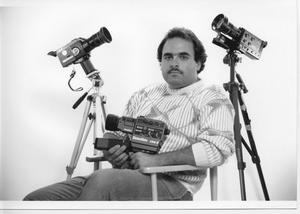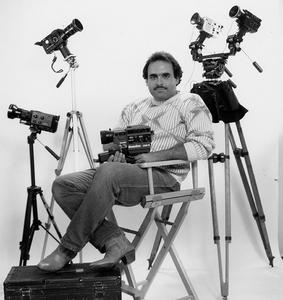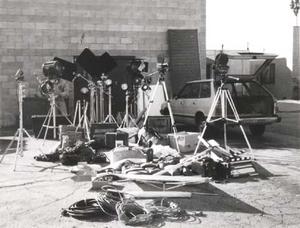|
|
|
Film vs HD & DV
 |
| Photo by Randy Baldwin |
Super-8 Cameras Offer Tremendous Flexibility
For more Information
on my 20 plus years
making films and videos,
please visit Alex LOGIC.
I am also an ideas person,
and an excellent collaborator.
I believe that a Super-8 camera with several frames per second options, plus several film stocks to choose from, allows the film maker tremendous artistic choices. Shooting location special effects with a Digital Camera is basically unnecessary because the exact same digital effects can usually be created when editing digitally. However, a Super-8 camera offers different filming and shutter speed choices that actually create different effects that don't have the same look when created by a computer.
The picture above and to the left was taken by Randy Baldwin about 15 years ago. The Picture to the right features me holding a Beaulieau 7008 (courtesy of Pro 8mm Film, Processing & Super-8 Camera Sales and in a clockwise arrangement a Nikon R-10, and a Canon 1014-XLS. Below left, I'm holding the same Beaulieu 7008. Clockwise is a Canon 1014-XLS, a Nikon R-10, and mounted on the same tripod via an arm extension bracket is a Eumig 881 PMA and a Eumig 860 PMA. Two cameras on one tripod, who knew!
The Super-8 cameras pictured below left are some of my favorite Super-8 Cameras of all time. These Super-8 cameras carry an abundance of special filming functions. What these Super-8 cameras lack in overall resolution when compared to 16mm & 35mm they make up for with the incredible array of filming options that are not as easily available on 16mm or 35mm cameras.
Pin Registered Super-8 Cameras that can film up to 300 frames per second were made at one point. However they do not have orientable viewfinders and that can pose a problem if one has to track action.
The picture at the bottom of the page shows all of the film and lighting gear that I have managed to put into my compact subaru station wagon at the same time!
Several other brands of Super-8 cameras that are not pictured are out there as well. Agfa, Argus, Bell & Howell, Bauer, Nizo, Elmo, Leicina, Bauer Royal, Yashica, Porst, Cosina, Minolta, Noris, Bolex, Chinon, Sankyo, Nalcom, GAF, Leicina, Revere, Revue, Ricoh, Rollei, Saimec, Sears, Vivitar are just some of the other Super-8 Camera brands not pictured on this page that were popular in their hey day and continue to be available 30-40 years after they were first made!
Super-8 Film List is a great place to find a listing of practically every Super-8 camera ever made.
|
 |
| Photo by Randy Baldwin |
Digital Film Schools and Film.
In my opinion, any Digital Video School that does not offer at least ONE film class is behaving irresponsibly. It may be wise to not support digital schools with your tuition if they have completely snubbed film.
If a film school has numerous digital video classes, they can easily accommodate a couple of film classes as well. It would be interesting to see digital film schools actually have one class split into two groups, one shoots a scripted project in film while the other one shoots the same project in video.
My pro film position has nothing to do with actual digital technology. It has everything to do with the way digital video is promoted. The over promotion of digital technology at the expense of the wonderful filmic tools that already exist isn't necessary nor is it productive.
I believe there is room for both Film and Digital to peacefully co-exist for at least the next 10 years and well beyond. If digital advocates continue their aggressive tactics of slamming film every chance they get, many will miss out on the advantage of learning how both digital and film technology work independently of each other.
Did you know that most people incorrectly believe that EVERYTHING is shot digitally nowadays? Most television shows opening credits mention that they are broadcasting in HI-DEF DIGITAL WITHOUT ever mentioning that the actual program itself was shot on film! This deception works against people's basic understanding of how much film is still being shot, even in 2008.
While we constantly are bombarded by how great digital video is, a Super-8 Camera bought in 1980 could still be in use today. But how many camcorders have you purchased since 1980? The average number could easily be 6-10 camcorders, representing a multitude of videotape formats!
The digital "revolution" has led to the homogenizing of talent. Artistic/Professional positions such as writer, cameraperson, editor, and producer are now being replaced by PREDATORS in many news and reality television shows. A predator is a person who wears multiple hats and writes, shoots, edits, and produces a news or reality television segment. Predators do all four of these positions equally well (you can draw your own conclusions about what that really means).
I witnessed an award winning promotions writer lose out on a full time promotions position to someone who couldn't write as well, but could edit video faster. When the written word matters less than the ability to add whiz bang video and sound editing effects via computer editing, we all lose, many just don't realize it. Nowadays, you probably have a better chance of retaining your job if you can wear the different hats of a predator, but I believe everything still starts and ends with the written word.
|
 |
| Photo from Super-8 frame by Alessandro Machi |
Super-8 Film vs HD and DV video.
Some wonder why they should even consider shooting on film when Digital Video (DV) and Hi-Definition Video Cameras provide an ever increasing number of videotaping options with each passing year. Even digital still cameras are being used in some video productions. At last count a Panasonic High Def camera offered over 60 different videotaping options.
While the "more the merrier" options can seem enticing, problems can arise when these different types of videotaping options are merged onto a computer editing timeline or when mixed with other video formats. Different video frame rates, resolutions and pixel sizes when combined on a Non Linear Editing timeline may end up causing editing problems.
However, when a project is shot on film, a variety of film stocks can be mixed together and these different film stocks can all be transferred to any video format, even formats that only exist in the future. Film is more expensive to shoot, process, and transfer to video than just shooting video. The benefits of film include a look that is still different from video, many specialized film stocks each with it's own unique quality, and the ability to transfer to any digital video format or computer file that you want to transfer to.
Should you really care if you shot a square video pixel versus a round video pixel? This round video pixel in a square video hole becomes critical when a video project that was originated on video is finally edited together. If you have ever had trouble burning a dvd after you finished all of your NLE editing, it could be nothing more than one shot mixed in with mismatched video pixels!
Just one shot in an entire video project that has a "different" video pixel size can stop a dvd burner from making your dvd. Virtually any Digital "Effects" created by a Digital Camera can also be created when one is editing digitally, thereby rendering on location digital cinematography special effects somewhat pointless. Digital still cameras are becoming somewhat of the new effects toy in the digital video world. The amount of digital still choices can be unnerving to wade through. No matter what you buy, the odds are a friend or an expert will tell you you should have bought a different digital camera, or waited for the next generation of digital camera.
Super-8mm.net - The Many Advantages of Super-8mm Filmmaking are Revealed.
Page-1 Super-8mm Overview.
Page-2 Super-8mm Film Advantages Explored
Page-3 Super-8mm Film Production News
Page-4 Music Video Techniques.
Page-5 Labs & Transfers.
Page-6 8mm Film Subscription Magazines.
Page-7 Flicker Super-8 Shooting Strategies
Page-8 Using Polaroids.
Page-9 Super-8 Cameras.
Page-10 Super-8 Forums.
Super-8mm.com - Super-8mm Low Budget Feature Filmmaking Techniques.
Page-1 Super-8 Links, Overview & Methods.
Page-2 Super-8 Guerilla Filmmaking.
Page-3 Indoor & Outdoor Locations.
Page-4 Super-8mm Film Stock Strategies.
Page-5 Super-8 Production News & Notes.
Page-6 A Good SoundTrack Can Make Your Film.
Page-7 Using Quiet Super-8 Cameras.
Page-8 Best Script Concepts for Super-8mm.
Page-9 Acquiring Same Model Super-8 Cameras.
Page-10 One Stop Super-8 Film Labs.
|
|
|
|
|